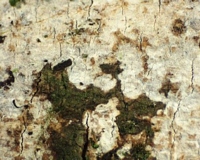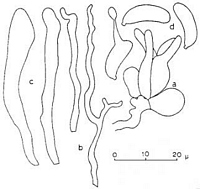|
 Exidiopsis mucedinea Exidiopsis mucedinea
SynonymsSebacina mucedinea
BiostatusPresent in region - Indigenous. Non endemic
Images (click to enlarge)
Caption: Exidiopsis mucedinea, M 414-1
Owner: B.C. Paulus |  |
Article: McNabb, R.F.R. (1966). New Zealand Tremellales - II. New Zealand Journal of Botany 4(4): 533-545 (http://www.rsnz.org/publish/abstracts.php).
Description: Fructifications arid-waxy, resupinate, thin,
effused, indeterminate, forming irregular areas to 15 cm in longest dimension,
pruinose. white to creamy white when fresh, changing little on drying; margins
concolorous. adnate. In section to 100 µm, thick, consisting of basal layer
and hymenium; granular calcareous material scattered abundantly throughout fructification.
Basal layer thin, composed of compact, interwoven, indistinct hyphae lying parallel
with substratum, clamp connections present. Hymenium composed of dikaryophyses
and basidia; dikaryophyses extremely variable in shape, typically nodulose,
irregularly branched apically, 1.5-3 µm diam. intergrading through simple, cylindrical
dikaryophyses to clavate, gloeocystidia-like structures to 11 µm diam.; probasidia
subglobose to obovate, with basal clamp connections, formed in groups, 11.4-15.6
x 8-12.5 µm, becoming 2-celled by longitudinal septa or longitudinally cruciate-septate:
sterigmata cylindrical, to 30 x 2.5-3 µm. Basidiospores curved-cylindrical to
allantoid, hyaline, apiculate, 11-15.5 x 3.7-4.5-(6) µm. Germination by repetition.
Habitat: Angiosperm and occasionally gymnosperm bark
and wood.
Notes: The degree of variability in the shape of
dikaryophyses appears to be a characteristic feature of Sebacina mucedinea.
In New Zealand collections there is a gradation from irregularly branched dikaryophyses
to stout, clavate, gloeocystidia-like structures with hyaline contents. Similar
variation was observed in Tahitian material by Olive (1958, p. 23), but the
clavate structures were interpreted by him as gloeocystidia. Olive also noted
similar structures in the type of S. mucedinea and for this reason placed
the species in section Bourdotia.
Neither Martin (1944, p. 69) nor Wells (1957,
p. 48) mentioned the presence of gloeocystidia-like structures in S. mucedinea.
In a later publication. Wells (1959, p. 560) excluded the species from the genus
Bourdotia on the grounds that these structures were not homologous with
the gloeocystidia possessing yellow, granular contents found in Bourdotia.
In addition, Wells commented that basidium development was not typical of Bourdotia.
On the basis of New Zealand material I am inclined to agree with Wells, for
in all collections examined the gloeocystidia-like structures lack yellow or
brown, granular contents, although their walls may be tinted yellow. However,
any disagreement over the interpretation of these structures only serves to
support Olive's contention that it is undesirable to use the presence or absence
of a single character as a basis for generic separation.
Sebacina mucedinea may be distinguished by the thin, white, mucedinoid fructifications, variable
dikaryophyses, and curved-cylindrical to allantoid spores. It is a common species
in New Zealand.
|